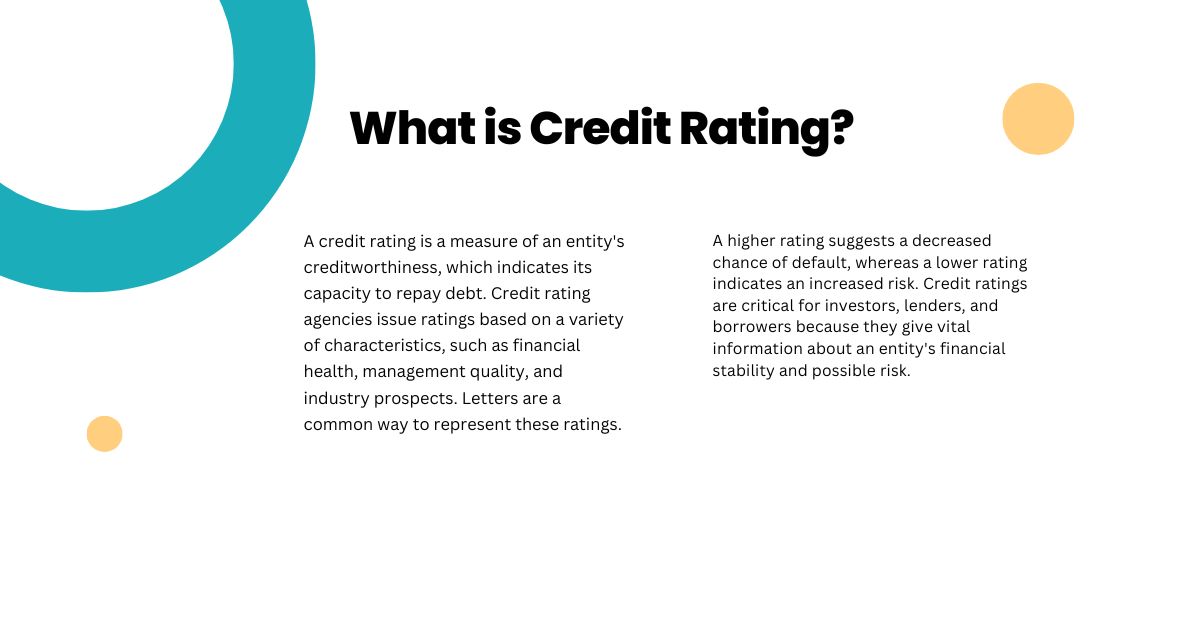A credit rating is a credit agency’s assessment of an individual, government, or business’s ability and preparation to fulfill its debts with integrity and on time. There is also a credit rating grade ranging from AAA to D that indicates how safe your investment will be.
There is a credit rating agency and a credit bureau; the credit agency provides their view regarding a panhandler’s prospective debt repayments, while the credit bureau discusses the panhandler’s previous debt repayments. In this post, we will explore credit ratings and their relevance, rating scales, and the many credit rating agencies accessible in India.
What is Credit Rating?

A credit rating is a measure of an entity’s creditworthiness, which indicates its capacity to repay debt. Credit rating agencies issue ratings based on a variety of characteristics, such as financial health, management quality, and industry prospects. Letters are a common way to represent these ratings.
A higher rating suggests a decreased chance of default, whereas a lower rating indicates an increased risk. Credit ratings are critical for investors, lenders, and borrowers because they give vital information about an entity’s financial stability and possible risk.
Types of Credit Ratings
There are two primary types of credit ratings:
1. Investment-Grade Ratings: These ratings are assigned to entities deemed to have a low risk of default. They are generally considered safe investments and often have lower interest rates. Examples of investment-grade ratings include AAA, AA, A, and BBB.
2. Speculative-Grade Ratings: Also known as “junk bonds” or “high-yield bonds,” these ratings are assigned to entities with a higher risk of default. They typically offer higher interest rates to compensate for the increased risk. Examples of speculative-grade ratings include BB, B, CCC, CC, and C.
It’s worth noting that credit rating organizations employ different grading systems and symbols, but the broad difference between investment-grade and speculative-grade stays unchanged.
Importance of Credit Ratings
Credit ratings play a crucial role in the financial world. They provide a standardized measure of an entity’s creditworthiness, helping various stakeholders make informed decisions.
For Investors:
- Risk Assessment: Credit ratings help investors assess the risk associated with investing in a particular bond or debt instrument. A higher rating indicates lower risk, while a lower rating suggests higher risk.
- Investment Decisions: Investors can use credit ratings to select investments that align with their risk tolerance and return expectations.
- Portfolio Diversification: Credit ratings can help investors diversify their portfolios by including a mix of investment-grade and speculative-grade securities.
For Lenders:
- Loan Approval: Credit ratings help lenders determine the creditworthiness of borrowers and make informed decisions about loan approvals.
- Interest Rate Determination: Lenders often use credit ratings to set interest rates on loans. A higher credit rating may lead to lower interest rates, while a lower rating may result in higher interest rates.
- Risk Management: Credit ratings help lenders assess the risk of default and take appropriate measures to mitigate it.
For Issuers:
- Access to Capital: A higher credit rating can improve an issuer’s access to capital markets and lower the cost of borrowing.
- Market Perception: A strong credit rating enhances an issuer’s reputation and market perception, attracting investors and lenders.
- Financial Stability: Maintaining a favorable credit rating can contribute to an issuer’s financial stability and long-term success.
In summary, credit ratings serve as a valuable tool for investors, lenders, and issuers to assess risk, make informed decisions, and promote financial stability.
Users of Credit Ratings
A wide range of people and organizations use credit ratings to evaluate the creditworthiness of entities. Here are the primary users of credit ratings:
Investors:
- Individual Investors: Use credit ratings to evaluate the risk associated with investing in bonds, mutual funds, and other debt instruments.
- Institutional Investors: Such as pension funds, insurance companies, and hedge funds, rely on credit ratings to make informed investment decisions and manage their portfolios.
Lenders:
- Banks and Financial Institutions: Use credit ratings to assess the creditworthiness of borrowers and determine appropriate interest rates and loan terms.
- Non-Bank Lenders: Including credit unions and private lenders, also consider credit ratings when making lending decisions.
Issuers:
- Corporations: Use credit ratings to attract investors and obtain financing at favorable terms. A higher credit rating can lead to lower interest rates on debt.
- Governments and Municipalities: Use credit ratings to assess their borrowing costs and manage their debt.
Regulators:
- Regulatory Agencies: Use credit ratings to monitor the financial health of institutions and assess systemic risk.
Other Users:
- Analysts and Researchers: Use credit ratings to analyze market trends and make predictions.
- Rating Agencies Themselves: Use credit ratings to assess the creditworthiness of other rating agencies.
What is Credit Score?
A credit score is a numerical measure of a person’s creditworthiness, showing their capacity to pay back borrowed funds. It is calculated using data from a credit report, which includes payment history, credit usage, length of credit history, credit kinds used, and current credit queries.
A better credit score indicates a lesser chance of default, making it simpler to get loans on more favorable terms, such as lower interest rates. Conversely, a lower credit score may limit loan availability or result in higher interest rates.
What’s the Difference Between a Credit Rating and a Credit Score?
While both credit ratings and credit scores analyze an entity’s creditworthiness, they have different applications and scales. A credit score is a numerical rating provided to individuals, usually ranging from 300 to 850, that indicates their chance of repaying debt. It is based on information from a credit report, including payment history, credit utilization, and credit history duration.
A credit rating, on the other hand, is a letter grade given to firms, governments, and other organizations in order to assess their overall creditworthiness and danger of default. Credit rating agencies use a variety of indicators, including financial performance, debt levels, and industry trends, to provide a rating that ranges from AAA (highest) to D (lowest).
If you want to read more financial blogs, you can also read these blogs:
- Top 10 Stock Brokers in India 2024: Your Guide to Profitable Investments
- What is Budgeting in Finance? A Comprehensive Guide to Financial Planning
What Does a Credit Rating Tell an Investor?
A credit rating gives investors a crucial assessment of a company’s financial health and capacity to satisfy its debt commitments. A better credit rating suggests a decreased risk of default, which increases the chance of timely interest and principal payments.
It enables investors to assess the safety of their investments and make educated judgments regarding the possible risks and rewards connected with a certain debt instrument. Understanding credit ratings allows investors to analyze the creditworthiness of a firm or government and make educated decisions about their investment portfolio.
Who Gives Credit Rating?
Credit ratings are provided by specialist organizations known as credit rating agencies. These organizations hire analysts to painstakingly examine the financial health, operational performance, and overall risk profile of diverse entities, such as enterprises, governments, and municipalities. Standard & Poor’s (S&P), Moody’s, and Fitch Ratings are three of the world’s most famous credit rating firms.
These agencies play an important role in the financial markets by offering independent ratings of creditworthiness, which influence investment choices, interest rates, and general market mood.

